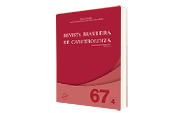Pulmonary Function in Long-Term Survivors of Childhood and Adolescence Osteosarcoma: Case Report
DOI:
https://doi.org/10.32635/2176-9745.RBC.2021v67n4.1345Keywords:
Osteosarcoma, Lung Volume Measurements, Spirometry, Oscillometry, Antineoplastic AgentsAbstract
Introduction: Chemotherapy used in osteosarcoma have the potential to cause lung damage. The objectives were to analyze lung volumes and capacities, and respiratory muscle strength of patients treated with chemotherapy and surgery for osteosarcoma. The study was designed as a prospective case-series of patients, through the analysis of spirometry, impulse, oscillometry, and manovacuometry tests. Case report: In twenty-one patients, the median age at diagnosis was 15 years, and at inclusion, 30 years. The median disease-free survival time was 10 years. Eight different chemotherapeutic agents were used: cisplatin, doxorubicin, methotrexate, carboplatin, ifophosphamide, epidoxorubicin, cyclophosphamide and etoposide. There were test abnormalities in 14 patients (66.6%), with mild obstructive disorders on spirometry in three patients (14.3%), and obstructive patterns on oscillometry in seven patients (33.3%). On spirometry, the mean ± standard deviation (SD) values of forced vital capacity (FVC) were 91.9%±12.2; for forced expiratory volume in one second (FEV1) were 87.4%±12.2 and FEV1/FVC ratios, 95.4%±7.9. On oscillometry, mean ± SD values for resistance at 5 Hz were 126.2%±36.2; for resistance at 20 Hz, 128.4%±32.4; reactance at 5 Hz, -0.75±0.68 kPa/L/s; for resonant frequency, 15.6±4.2 Hz. Nine patients (42.8%) had reduced maximum pressures on the manovacuometry: Maximum Expiratory Pressure (MEP) were reduced in eight patients, and inspiratory (MIP) in three. The mean ± SD MIP was 89.4±29.5; MEP, 88±37.7. Conclusion: Mild abnormalities in pulmonary function tests in this series of patients were observed years after treatment for osteosarcoma.
Downloads
Downloads
Published
How to Cite
Issue
Section
License
Os direitos morais e intelectuais dos artigos pertencem aos respectivos autores, que concedem à RBC o direito de publicação.

This work is licensed under a Creative Commons Attribution 4.0 International License.









